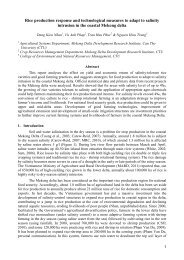start-with-the-park
Create successful ePaper yourself
Turn your PDF publications into a flip-book with our unique Google optimized e-Paper software.
76 Start <strong>with</strong> <strong>the</strong> <strong>park</strong><br />
CASE STUDY<br />
Regent’s Park, central London<br />
107 hectares<br />
Plan well ahead<br />
Construction period<br />
1816–26 (although fur<strong>the</strong>r property development<br />
occurred in <strong>the</strong> next century)<br />
Background<br />
The area now occupied by <strong>the</strong> <strong>park</strong> was once a hunting<br />
ground of Henry VIII. John Nash was asked to draw up<br />
designs by his friend and patron, <strong>the</strong> Prince Regent.<br />
At <strong>the</strong> same time he had been instructed to develop<br />
plans for a new street connecting Portland Place<br />
and Charing Cross. Work on <strong>the</strong> <strong>park</strong> itself, including<br />
<strong>the</strong> Regent’s Canal and <strong>the</strong> boating lake, <strong>start</strong>ed in<br />
1816. Over <strong>the</strong> next 10 years, Nash developed <strong>the</strong><br />
fine terraced properties that adjoin <strong>the</strong> <strong>park</strong>. The <strong>park</strong><br />
has since changed significantly – from a semi-private,<br />
picturesque, semi-rural green <strong>park</strong> grazed by livestock<br />
to a public <strong>park</strong> that now includes more formal gardens,<br />
sports pitches and London Zoo.<br />
The architect John Nash developed Regent’s Park<br />
as <strong>the</strong> centrepiece of an ambitious property venture.<br />
He believed that ‘landowners infinitely prefer living near<br />
open space…a <strong>park</strong> where <strong>the</strong>re are opportunities<br />
for riding, driving, and walking is an irresistible magnet’.<br />
This <strong>park</strong> was successful both in raising <strong>the</strong> value of<br />
adjoining sites and in creating a magnificent, wellconnected<br />
set-piece of urban development.<br />
Planning and design<br />
Nash’s scheme included terraces of housing that<br />
enclosed a roughly circular <strong>park</strong>, linking in <strong>with</strong> <strong>the</strong> major<br />
processional route to Westminster. The <strong>park</strong> is shaped<br />
by <strong>the</strong> Inner and Outer Circles and <strong>the</strong> Broad Walk.<br />
The design is intended to create serially revealed<br />
views of <strong>the</strong> boating lake and <strong>the</strong> terraces. The edge<br />
of <strong>the</strong> <strong>park</strong> is enclosed and overlooked by an almost<br />
continuous series of terraced houses.<br />
There are areas <strong>with</strong>in <strong>the</strong> <strong>park</strong> <strong>with</strong> a wide range of<br />
different characters, including <strong>the</strong> secluded and highly<br />
enclosed Inner Circle, <strong>the</strong> formal planting of <strong>the</strong> Avenue<br />
Gardens and larger open spaces.<br />
Outcomes<br />
The <strong>park</strong> is a highly successful green space in <strong>the</strong> heart<br />
of London, serving a large number of local, metropolitan<br />
and international users. Today it accommodates a huge<br />
range of different uses including sports, <strong>the</strong>atre, worship,<br />
education, residential buildings and <strong>the</strong> zoo. The original<br />
Nash terraced housing surrounding <strong>the</strong> <strong>park</strong> remains<br />
highly desirable. Around a third of <strong>the</strong> <strong>park</strong>’s expenditure<br />
is funded directly by income generated by commercial<br />
concessions, licences and rents.<br />
Lessons learnt<br />
• A well-designed and well-managed <strong>park</strong> can form<br />
<strong>the</strong> centrepiece of a successful residential area<br />
• Well-designed buildings of an appropriate scale<br />
can form a spectacular backdrop that enhances<br />
<strong>the</strong> experience of a <strong>park</strong> as a green space <strong>with</strong>in<br />
a fine urban context<br />
• The role and success of a <strong>park</strong> also rely on<br />
its connection to o<strong>the</strong>r green spaces and<br />
well-connected routes.





